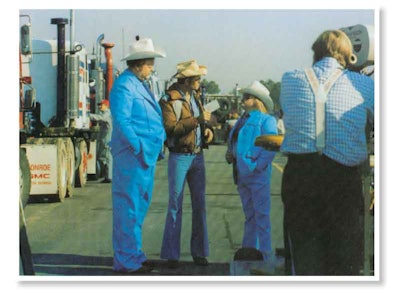
When “Smokey and the Bandit” hit theaters in 1977, its promoters had envisioned it as a lightweight B movie rather than the icon it became. It grossed the second largest revenue of all movies that year, outpaced only by “Star Wars.” The trilogy of “Smokey” films (with “Smokey and the Bandit II” in 1980 and “Smokey and the Bandit Part 3” in 1983) and the 1978 film, “Convoy,” portended a craze that swept the nation’s collective imagination of truckers as rebel cowboys. Yet “Smokey” is also just a corny comedy.
 In its May 1977 story on the making of “Smokey,” Overdrive noted that Director Hal Needham filmed the opening race at Atlanta’s Lakewood Speedway. This 1974 Kenworth W900A (top) is one of three used in the 1977 film. The trailer with the horse mural was made by Hobbs Trailers in Texas.
In its May 1977 story on the making of “Smokey,” Overdrive noted that Director Hal Needham filmed the opening race at Atlanta’s Lakewood Speedway. This 1974 Kenworth W900A (top) is one of three used in the 1977 film. The trailer with the horse mural was made by Hobbs Trailers in Texas.Burt Reynolds, as the Bandit, accepts a bet to deliver Coors beer from Texas to Georgia and meets Carrie (Sally Field), whose father-in-law to be (Jackie Gleason), the sheriff, plays the frustrated buffoon who’s on the losing end of a prolonged car chase.
“Smokey” opened with a drag race filmed in Atlanta. For the 1980 sequel, “Smokey and the Bandit II,” 40 truckers served as extras for scenes shot in Nevada, and 15 others were filmed in 1979 at the first-ever 200-mile bobtail race at the Atlanta International Speedway. Many of the movie’s truckers were recruited by Overdrive.
 Although Burt Reynolds (right) was the trucker delivering Coors in the first two “Smokey” movies, most of his hours logged were in the black 1977 Pontiac Firebird Trans Am Special Edition. Many say that Sally Field’s portrayal of Carrie launched the actress’s career, opening her for a larger repertoire than her flying nun role on television.
Although Burt Reynolds (right) was the trucker delivering Coors in the first two “Smokey” movies, most of his hours logged were in the black 1977 Pontiac Firebird Trans Am Special Edition. Many say that Sally Field’s portrayal of Carrie launched the actress’s career, opening her for a larger repertoire than her flying nun role on television. Jerry Reed, second from left, portrayed Snowman in the first two “Smokey” movies and was Bandit in “Smokey, Part 3.” He wrote and sang the movie’s hit theme song, “Eastbound and Down,” and drove the Kenworth W900As in the first film and the General’s Quarters GMC in the sequel, leading the way in truck scenes and races.
Jerry Reed, second from left, portrayed Snowman in the first two “Smokey” movies and was Bandit in “Smokey, Part 3.” He wrote and sang the movie’s hit theme song, “Eastbound and Down,” and drove the Kenworth W900As in the first film and the General’s Quarters GMC in the sequel, leading the way in truck scenes and races.The Bandit’s appeal has thrived, spurring devotees like Tyler Hambrick, of Newnan, Ga., to take his life-size replicas of the 1974 Kenworth W900A and a trailer adorned with a horse mural to trucking shows. (Visit smokeyandthebanditmodels.com). Both he and Bradley Wike, who customized a Bandit truck-and-trailer replica in Taylorville, N.C., have attracted visitors from all over the world, both at shows and on his website, bradsclassictrucks.com.

1961: The Jacobs Engine Brake
BY John Baxter
On the last page of Clessie Cummins’ 1967 book “My Days With the Diesel,” he writes of a project under development: “a relatively simple accessory which converts a diesel engine into a highly efficient air compressor whenever vehicle retardation is needed. This ‘engine brake’ will hold a 35-ton truck under complete control, limiting its speed to 19 mph, going downhill on a 10 percent grade — without the use of the service brakes.”
 Clessie Cummins invented the engine brake.
Clessie Cummins invented the engine brake.Both Cummins’ book and Jacobs Vehicle Systems’ website explain the development grew out of Cummins’ nerve-wracking ride in a runaway truck 30 years earlier. Later, as noted on the website, “An idea for a practical method came to Clessie in 1957 while in Phoenix, Ariz. [It] revolved around taking advantage of the perfectly timed motion already built into Cummins and Detroit Diesel engines; these engines have a third cam on the main camshaft that activates the fuel injector of each cylinder. A simple retrofit mechanism should be able to transfer this motion to open the exhaust valve.”
This ultimately led to the development of the engine brake of today. Jacobs was the first to exploit Cummins’ invention, but the expiration of the patent opened the door to competing products.
50 Years of Equipment Innovation
Visit OverdriveRetro.com to view some of the top 50 equipment milestones during Overdrive’s 50-year history. New items will be added through September 2011.
Let us know your favorite trucking memories. Write Lucinda Coulter at [email protected] or Overdrive, P.O. Box 3187, Tuscaloosa, AL 35403.













